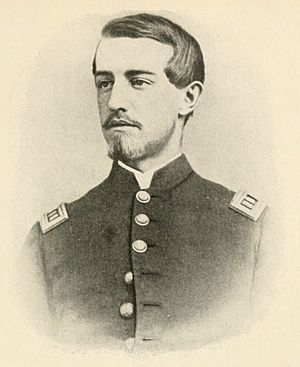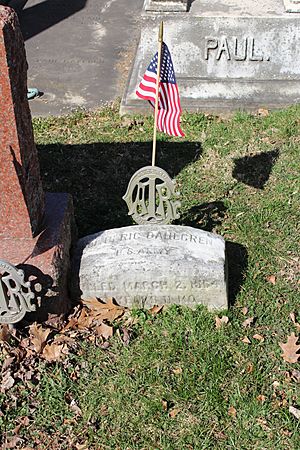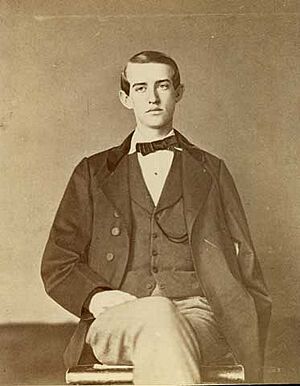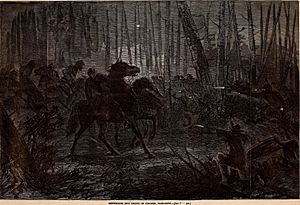Ulric Dahlgren facts for kids
Quick facts for kids
Ulric Dahlgren
|
|
|---|---|

Col. Ulric Dahlgren (seen here as a captain)
|
|
| Born | April 3, 1842 Bucks County, Pennsylvania, US |
| Died | March 2, 1864 (aged 21) near Stevensville, Virginia |
| Buried |
Laurel Hill Cemetery, Philadelphia, Pennsylvania
|
| Allegiance | Union |
| Service/ |
|
| Years of service | 1861–1862 (Union Navy) 1862–1864 (Union Army) |
| Rank | |
| Battles/wars | |
| Relations | John A. Dahlgren (father) Charles G. Dahlgren (uncle) |
Ulric Dahlgren (born April 3, 1842 – died March 2, 1864) was a colonel in the Union Army during the American Civil War. He was the son of Union Navy Rear Admiral John A. Dahlgren. His uncle, Charles G. Dahlgren, was a general in the Confederate Army.
Ulric Dahlgren fought in several important battles. He was wounded at the Battle of Gettysburg, which led to his leg being amputated. He returned to duty and was killed in 1864 during the Battle of Walkerton. This happened while he was leading a raid on Richmond, Virginia, the capital of the Confederacy.
After his death, Confederate soldiers found papers on Dahlgren. These papers seemed to order his troops to free Union prisoners, burn Richmond, and kill Confederate President Jefferson Davis and his cabinet. Southern newspapers published these documents, causing great anger. They claimed the orders came from President Abraham Lincoln. Union newspapers said the papers were fake. This big argument became known as the Dahlgren Affair.
Contents
Early Life and Family
Ulric Dahlgren was born on April 3, 1842, in Bucks County, Pennsylvania. He was the second son of Rear Admiral John A. Dahlgren. His uncle, Charles G. Dahlgren, lived in Mississippi and became a general for the Confederate Army.
His family moved to Wilmington, Delaware, in 1843. Then they moved to Washington, D.C., in 1848. After finishing school in 1858, Ulric learned civil engineering from his father. In 1859, he worked surveying land for his uncle, Charles G. Dahlgren, in Mississippi. In September 1860, he moved to Philadelphia, Pennsylvania, and started studying law.
Joining the Civil War
Dahlgren joined the military in March 1861. On July 24, 1861, he became part of the U.S. Navy. He helped defend Alexandria, Virginia. He returned to Philadelphia in September 1861 and continued his law studies. He also joined a light artillery company there.
In May 1862, he was sent to Harpers Ferry, West Virginia. He was put in charge of a group of Navy howitzers (small cannons). On May 29, 1862, Dahlgren went back to Washington for ammunition. He visited his father, who was meeting with President Abraham Lincoln and the U.S. Secretary of War Edwin M. Stanton. Lincoln asked Ulric about his military experiences. After Ulric shared his story, Stanton offered him a job in the U.S. Army. He became a captain and an aide-de-camp (assistant) to General Franz Sigel.
Key Battles and Injuries
Dahlgren fought in many important battles. These included the Second Battle of Bull Run, the Battle of Fredericksburg, and the Battle of Chancellorsville. He also fought in the Battle of Brandy Station and the Battle of Gettysburg.
During the Battle of Fredericksburg, he and sixty Union cavalry soldiers captured the city. They held it for three hours before having to retreat. But they managed to capture 31 Confederate prisoners. On March 1, 1863, he joined General Joseph Hooker's staff. He stayed on the staff when General George Meade took command of the Army of the Potomac.
On July 6, 1863, Dahlgren was wounded in the foot during a fight near Hagerstown, Maryland. This happened shortly after the Battle of Gettysburg. His leg had to be amputated below the knee. For his bravery, Dahlgren was promoted to colonel on July 24, 1863.
The Kilpatrick-Dahlgren Raid
After recovering from his injury, Dahlgren met Brig. Gen. Hugh Judson Kilpatrick. This was on February 23, 1864, at a party. Kilpatrick invited Dahlgren to join a secret mission. The plan was to attack Richmond, Virginia. They also wanted to rescue Union prisoners from Belle Isle. And they aimed to damage Confederate buildings and supplies. This mission is also known as the Battle of Walkerton.
On February 28, Kilpatrick and Dahlgren left Stevensburg, Virginia. Kilpatrick planned to attack Richmond from the North with 3,500 men. Dahlgren would attack from the South with 500 men. An unexpected winter storm brought snow, sleet, and rain. This slowed down their attack. Dahlgren's troops were led to a river crossing on the James River. But they could not cross because the water was too high from recent rains.
Dahlgren then changed his plan to attack Richmond from the East. They heard sounds of battle and rushed to help Kilpatrick. But they ran into a group of Confederate Home Guard soldiers. This stopped their advance. Dahlgren retreated East, trying to meet up with Kilpatrick's forces. Confederate soldiers kept attacking the Union troops as they retreated. The Union forces became separated.
On the night of March 3, Dahlgren and some of his men were ambushed. This happened near King and Queen Court House, Virginia. About 150 men from the 9th Virginia Cavalry attacked them. Dahlgren was shot four times and died on the battlefield.
The Dahlgren Affair
After Dahlgren died, a 13-year-old boy named William Littlepage searched his body. He was looking for valuables. Instead, he found a packet of papers. He gave these papers to his teacher, Edward Halbach.
The papers seemed to be orders. They said to free Union prisoners from Belle Isle. They also said to give them things to burn the city of Richmond. The orders also stated that Union troops should capture and kill Confederate President Jefferson Davis and his cabinet.
The Richmond Examiner newspaper published these papers. This caused huge anger in the South. Newspapers compared Dahlgren to Atilla the Hun, a fierce ancient warrior. They also guessed that President Lincoln himself had given these extreme orders.
Union newspapers claimed the orders were fake. Dahlgren's father strongly denied his son would be involved in such a scandal. Union Major General George Meade had to personally tell Confederate General Robert E. Lee that the Union Army did not approve of such orders. This controversy might have played a part in John Wilkes Booth's decision to assassinate President Abraham Lincoln a year later.
It was never proven who wrote the orders. It could have been Dahlgren, Kilpatrick, Edwin M. Stanton, or President Lincoln. The papers misspelled Dahlgren's name, which makes it less likely he wrote them himself. After the war, the Confederate Government's papers were moved to Washington, D.C. Secretary of War Stanton personally asked for the Dahlgren papers. They have not been seen since.
Burial

Dahlgren was first buried in an unmarked grave at Oakwood Cemetery in Richmond. His father wanted Ulric's body returned for burial in Philadelphia. He traveled four times to Fort Monroe to try to arrange this. He even contacted the Confederate Commissioner of Exchange to formally ask for Ulric's remains.
The Union spy Elizabeth Van Lew used her connections in Richmond. She secretly dug up his remains. She then reburied them at a farm about 10 miles outside of Richmond. This was to prevent anyone from harming his body further. Ulric Dahlgren was eventually buried at Laurel Hill Cemetery in Philadelphia.




